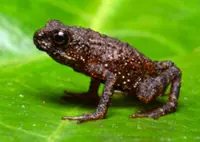Where have all the good men gone?
You may have heard such a cry following an ice-cream-fueled, tear-stained, post-breakup debrief session. Perhaps you've seen it as the title of some romantic column piece in a magazine selling fashion?
Well, if you are one of those poor unfortunate souls who need a hero, perhaps even a hero 'til the end of the night, you may be desperate enough to start looking for toads to kiss in the hope that they'll turn into your Prince Charming.
But butchering 80's pop songs and fairy tale tropes aside, toads are not that easy to find anymore as many are going extinct thanks to loss of habitat and climate change, among other inconvenient truths we try not to think about.
It has been said that one toad species thought to have gone extinct may be making a comeback to mend broken hearts and ecosystems after all. Is this true?
VERDICT:
TRUE
Time to put on some lipstick, as researchers from Universiti Malaysia Sabah (UMS) and Sabah Parks on Mount Kinabalu have rediscovered the Mesilau Stream Toad (Ansonia guibei) which was feared to have gone extinct following the destruction of their habitat due to the Mount Kinabalu earthquake.
UMS Institute for Tropical Biology and Conservation Associate Professor Dr Evan S.H. Quah said this species of toad was once relatively common but was feared extinct after the devastating earthquake in 2015.
The quake caused massive damage to the species’ habitat and was expected to have caused significant declines in the toad’s population and even potential extinction, she said.
This theory was backed by a survey in 2017 at Mesilau that failed to locate any specimens, and this resulted in the species being listed as Critically Endangered by the International Union for Conservation of Nature (IUCN), she said.
With funding from the Asian Species Action Partnership (Asap), the research team led by Quah set out to reassess the status of the species last year.
She said that the team was elated to rediscover a single sub-adult specimen of the Mesilau Stream Toad at its type locality in September 2023.
“Tadpoles of the toad were also recorded in the main Mesilau River and Tibabar Stream,” she said, adding that the findings are extremely encouraging as it not only indicates the species survived but is also breeding.
Quah said the research team is continuing to monitor the toads at Mesilau to gather more ecological data on the species post-earthquake.
The Mesilau Stream Toad still faces many ongoing threats, she said.
Firstly, it has an extremely restricted range and is confined only to the Mesilau watershed on Mount Kinabalu which makes it vulnerable to any extensive changes in the environment, she shared.
Second, the preliminary data collected by the team indicates that the habitat of the toad has not fully recovered after the 2015 earthquake, said Quah.
Landslides still frequently occur at the cliff faces exposed after the earthquake, especially during the rainy season so runoff and siltation from the landslides affect the water quality of the waterways where the toads breed, she explained.
“Finally, similar to other montane endemics, the Mesilau Stream Toad faces the ever-present threat of climate change,” she said.
Quah said as a species that evolved to thrive in the cool, moist conditions of high elevations, these toads would be vulnerable to changes brought upon by a warming climate.
“Thus, the data collected from this ongoing study is critical in the construction of a sound conservation plan to ensure the survival of the species. Details of the findings were just published this week in the journal Zootaxa,” she said.
There's hope for true love and the planet after all.






